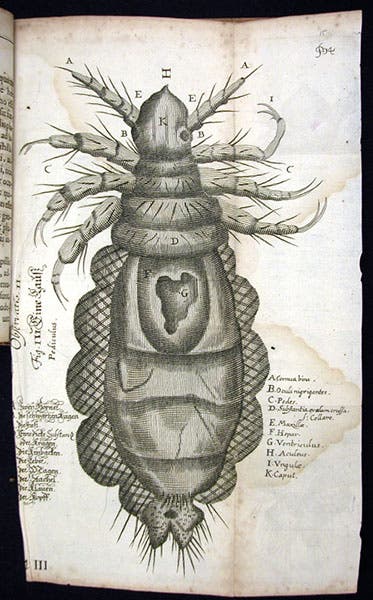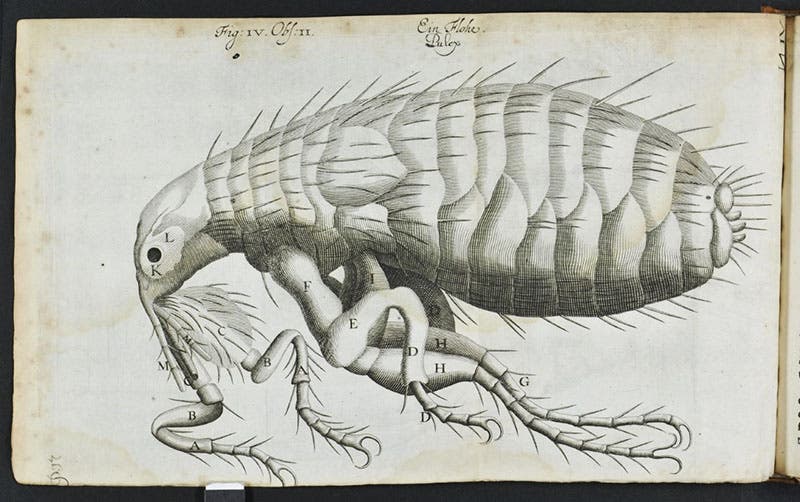Scientist of the Day - Johann Franz Griendel
Johann Franz Griendel von Ach was a German instrument maker and microscopist. He was born in 1631 and died in 1687, but we have no more precise birth and death dates than that. We celebrate him today because this is as good a day as any. We do know that he spent some years as a Capuchin monk before turning in his hood and setting up as an instrument maker in that city of instruments, Nuremberg. After some time in Dresden, he ended up in Vienna in 1684, where he wrote a book containing observations made through a microscope, an instrument of his own design and making. The book was published in Nuremberg in 1687, the year Griendel died. It was called Micrographia nova, a not-so-subtle way of informing the reader that the book was meant to replace the pioneering work on microscopy by Robert Hooke, Micrographia (1665).
The microscope that Griendel invented and used was shown in an initial engraving in his book (third image). Each of the three lenses was two-part, which was not that unusual, but the way he placed them was surprising, with the two curved sides facing each other. It is said that this system of lenses was difficult to use – no one else adopted it after Griendel – but Griendel seems to have had no problem getting magnifications that he claimed were 100 power. The evidence that his instrument was more than adequate lies in the 50+ engravings in the book, mostly of insects, but showing quite a variety of other objects, such as pencil points, razor blades, and tiny seeds, just like Hooke.
If Griendel's microscope lacked anything, it was the ability to draw its own pictures; for that, it had to rely on the hand of its owner, who was not artistically gifted. The best images in Griendel's book are the ones that were based on Hooke’s illustrations, such as the flea (see below) and the louse (fourth image), and they are not nearly as well drawn as Hooke’s, although they are just as impressively enormous. The various ants and weevils that Griendel drew on his own are almost grotesque; we show here a Hooke engraving of an ant (fifth image, below), so that you may compare it to one of Griendel’s (first image). But there is some indication in the text that he wanted them that way. He saw the microscopic world as a realm of monsters, which he was able to enlarge to delight and horrify his readers, just as ancient spectators of gladiatorial contests between rhinos and elephants were appalled and entertained. Indeed, Griendel describes a microscopic battle between a flea and a louse, as if it were just such a battle of behemoths in the Roman Colosseum.
Although Griendel probably had no role in the layout of his book or the way the plates were mounted and folded, it is still entertaining to see the way the head of the flea peeks out before it is unfolded (sixth image, above). We can only imagine what the reader thought when he unfolded the plate and saw the animal whose kin were no doubt present on the reader’s scalp (seventh image). We also show you Hooke’ flea for comparison (eighth image).
It is easy to look at Griendel’s flea and louse and see him as just a plagiarist of Hooke, but there are many observations in Griendel’s book that are totally original, details and images of various worms and bugs that Hooke never saw. It is just too bad that Griendel could not really draw.
We actually have two copies of Griendel’s book in our History of Science Collections; our second copy came with the bequest of the Ruth Patrick Collection to the Library some years ago. The images here are from copy one, which is the one we have scanned. There was also an edition of that same year (1687) in German, but both our copies are in Latin.
It is probably no surprise that there exists no portrait, so far as we know, of the shadowy former-Capuchin German microscopist, Johann Franz Griendel.
Dr. William B. Ashworth, Jr., Consultant for the History of Science, Linda Hall Library and Associate Professor emeritus, Department of History, University of Missouri-Kansas City. Comments or corrections are welcome; please direct to ashworthw@umkc.edu.













